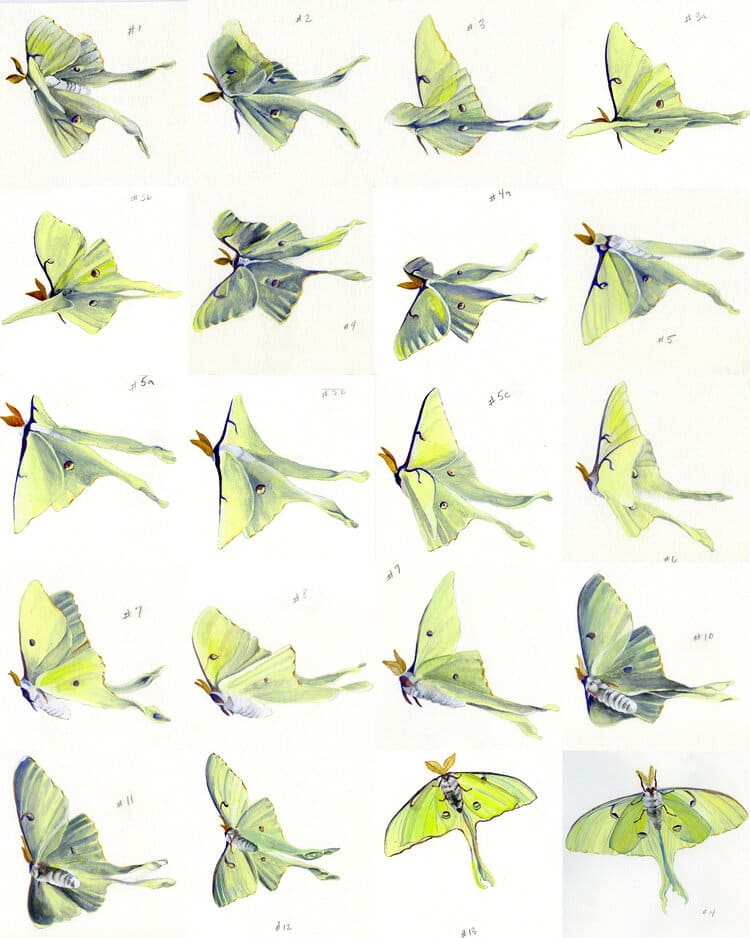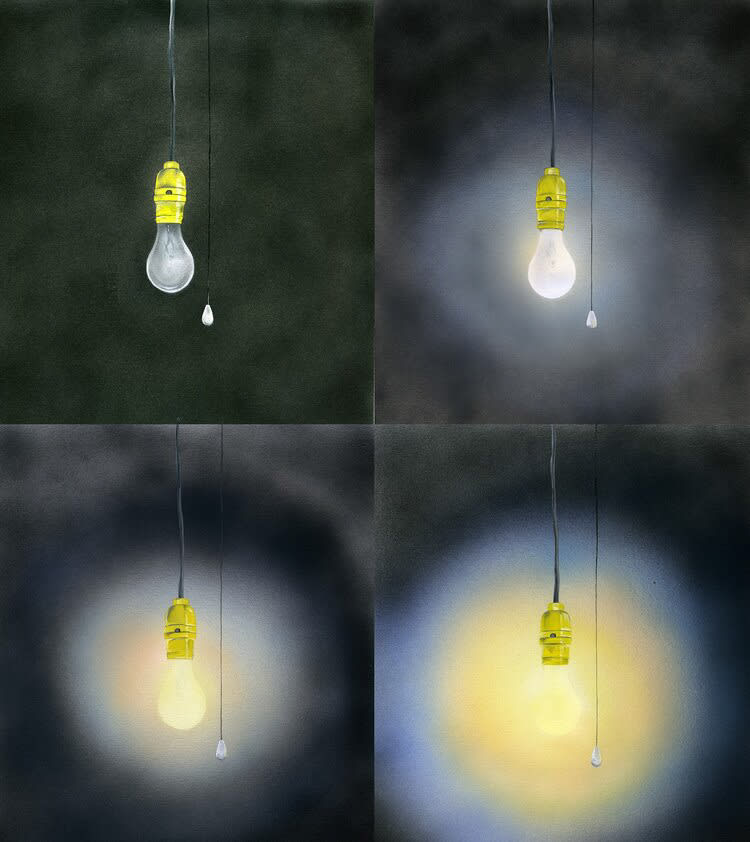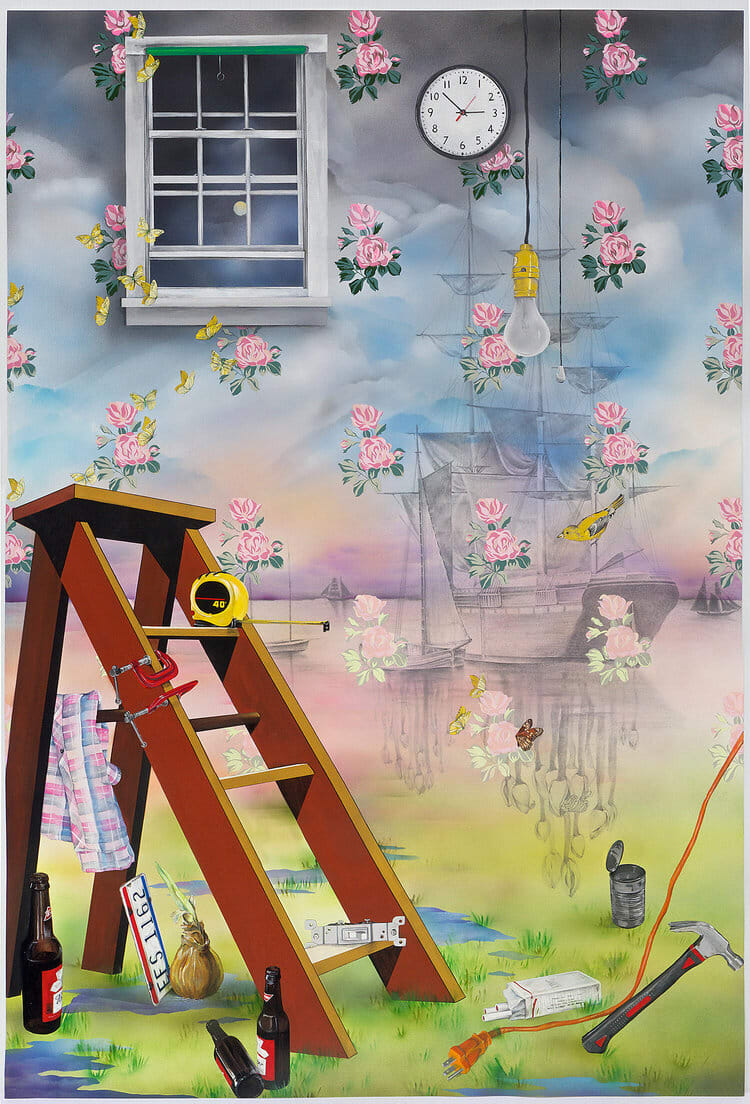I think in pictures. Like a single seed that eventually forms an arbor, this particular trait has determined the entire infrastructure of my practice as an artist and has continued to shape my life in many other ways.
Hopeless with verbal directions, I am an excellent navigator with a map (in the shapeless expanse of my mind, without visual signposts it’s hard to see the way ahead). As a champion list-maker, my morning ritual of writing down the pile of tasks that accumulated in my sleeping brain becomes crucial visual evidence of my thoughts. The act of recording them, akin to the act of drawing, makes those thoughts more concrete to me. In both cases, the internal visual becomes something externally physical, a tangible thing that I can look upon again, reinforcing, confirming the existence of the other.
"For nearly a decade I have been making still pictures of things as they pass through time, attempting to capture with drawing what is ephemeral. Now, rather than stopping time, I am activating it."
When I read books or listen to music, the words appear to me in images. I see what they’re singing, what they’ve written. The words are vehicles that take me across the pictorial narrative of my own life. As an artist I pick my way across this landscape, using a combination of processes to create my work. I begin with the use of an airbrush to create an atmospheric base on paper, then the narrative objects and landscape are constructed in layers with graphite, ink, gouache, stencils, and collage. For over a decade I have used drawing to translate interior images for the outer world, creating densely layered, melancholic, and playful reflections of the mind’s life.
The first time I heard English composer Benjamin Britten’s orchestral piece Moonlight was a powerful occasion because of what I saw. Unique, in a way, because I saw sounds, not lyrics. The haunting, crawling strings became an incandescent full moon dragged across a night sky. The flute became flickering fire flies and street lamps. An entire narrative began to unfold.
For years I would listen to Britten’s “Four Sea Interludes,” eager to return to Moonlight, the third interlude, because my visual mind had begun to imagine more than still pictures. Moonlight had become a “place,” harboring a story that grew more elaborate with each visit. The same desire that compels me to make drawings now had a new dimension. Something else was required. The music had to be translated into moving pictures.

Britten’s “Four Sea Interludes” was written as orchestral scene changes for his opera, Peter Grimes. Maybe his most famous opera, Peter Grimes was inspired by The Borough, a poem by George Crabbe, which details several narratives in a small seaside village inspired by the coastal landscape of Suffolk, England. The “Four Sea Interludes” reflects Britten’s ardent attachment to the sea and Suffolk, his childhood home. Sonorous and compelling, the interludes are often performed on their own. Peter Grimes is a powerful example of Britten’s own affinity for interpretation, spending much of his career translating the written word into music. He composed scores for theatre and cinema, as well as orchestral pieces based on the works of W.H. Auden, Emily Bronte, and Thomas Mann.
"To draw is to record. In its most poetic sense, drawing is evidence of the presence of life: the first footprints in fresh snow, the arc of white cloud behind an airplane, a signature, a fossilized fern in bedrock."
Britten is also known for his contribution to children’s music education with the beloved The Young Person’s Guide to the Orchestra from 1945. Broken into sections, beginning with a full orchestra, the composition goes on to isolate families of instruments into themes and variations, audibly demonstrating the unique job of each of the parts that make up the whole. It is in this spirit that another famous orchestral piece written for children was structured. In Peter and the Wolf, a childhood favorite, Prokofiev’s narrator begins, “Each character in this story is represented by a different instrument.”
After years of contemplation, I began to nurture my desire to translate Moonlight into an animation. This formula, of assigning characters to musical instruments, became a formative idea. As I turned my thoughts to making the animation, I was surprised at how, seemingly undetected, the interludes had become four fully formed narratives in my mind. The process of translating instruments/sounds into unique visual elements would anchor my approach as I wrote each of the scripts. In the first interlude, Dawn, I began to see a predawn conversation taking place between a lone lightbulb hanging from a kitchen ceiling and the distant sun hidden beneath the horizon. The lightbulb, embodying the violins, appeared to “call” to its counterpart; the horns and timpani became the sun’s response, its eventual rise. An intermittent clarinet turned into a Luna moth making its way across the landscape, drawn to the glow of the light. Over time, another wish took shape. I dreamt not only of creating the animation, but also that its completion would culminate in a performance, a screening with live accompaniment by an orchestra.

The John S. and James L. Knight Foundation makes funding available bi-annually for art projects in my hometown of Akron, Ohio and other major US cities as part of their Knight Arts Challenge (KAC). The process is tiered and opens with a community-wide call for people’s “best idea for the arts.” The starting prompt was simple enough: describe your “best idea” in 150 words or less. The process led me from that succinct description to a final application that ultimately included partnerships with a local orchestra and digital production studio, the creation of an administrative support team, a $150,000 project budget, and a feasible plan to raise the $50,000 that the KAC would hopefully match.
In September 2019, I was awarded a $54,000 matching grant from the Knight Foundation for the creation of my project, “Ordinary Magic: A Sunday in the Cuyahoga Valley.” In collaboration with a production studio, I am creating a fifteen-minute animation that visually interprets Britten’s “Four Sea Interludes” which will be screened with live accompaniment by the Akron Symphony Orchestra in the autumn of 2022.
When I received the congratulatory call from the Knight Foundation I was stunned. In a flash, each of the thoughts that led to that moment synthesized into a sudden realization of the daunting task ahead. I would have to move forward without a map into a field for which I have deep affection but no expertise.

As I reflect on the past year of work on my first animations, the nature of my relationship with time is changing, causing my practice to undergo a visually subtle but perceptively radical transition. For nearly a decade I have been making still pictures of things as they pass through time, attempting to capture with drawing what is ephemeral. Now, rather than stopping time, I am activating it.
To draw is to record. In its most poetic sense, drawing is evidence of the presence of life: the first footprints in fresh snow, the arc of white cloud behind an airplane, a signature, a fossilized fern in bedrock. In novelist and playwright Christopher Isherwood’s “A Berlin Diary” he wrote:
I am a camera with a shutter open, quite passive, recording, not thinking. Recording the man shaving at the window opposite and the woman in the kimono washing her hair. Some day, all this will have to be developed, carefully printed, fixed.
As Isherwood mentally recorded pictures to develop later, with each drawing I set out to record or fix what is fleeting. When I begin a drawing, what I hope or intend to communicate is planned, sketched in advance. As I work, I treat each drawing’s rectangular borders like an aperture that opens when I make the first mark and closes when I complete the last. Each drawing is an accumulation of images, culled from mental scraps and observations, interwoven with visual evidence of the time in which it was made. An artifact of that time might be represented by a pine cone I collected on a walk, or a particular bird I spotted at the feeder. Like a glass jar full of ocean water and sand marked with the date of collection, the artwork is simultaneously a time capsule and a story. Finally, aperture closed, the drawing is a winding, layered, nonsensical narrative that both reflects and captures something of the world.

As I’ve transitioned from making still drawings to moving images, what has been most remarkable is learning the mechanisms it takes to create the perception of movement. Drawn elements are no longer singular; they are “frames” strung together to create action. Human vision processes roughly twelve frames per second, turning them into motion. The more frames, the more fluid the movement. Individually, these frames are almost invisible to the eye; ultimately, they are understood by the viewer through accumulation rather than contemplation. For over a decade I’ve used drawing to capture thoughts and moments, to concretize them, to immobilize them for examination. Now my efforts, my drawings, succeed in a way, when they can’t be individually perceived.
"the artwork is simultaneously a time capsule and a story. Finally, aperture closed, the drawing is a winding, layered, nonsensical narrative that both reflects and captures something of the world."
In animation, the term “onion skinning” refers to the transparent layering of image onto image to visualize movement by seeing several frames at once. Each drawing is like an apparition that the mind registers as it disappears into another drawing. This conjures something Britten is supposed to have said: “Composing is like driving down a foggy road toward a house. Slowly you see more details of the house—the color of the slates and bricks, the shape of the windows. The notes are the bricks and mortar of the house.”
This quote leads me to think of the moment Britten’s music first passed through my ears, entering my mind, which formed it into pictures, becoming the foundation for this new experience. A seemingly unremarkable event that I will now spend years carefully working to capture, grateful for the moonlight on the foggy road ahead. ◘